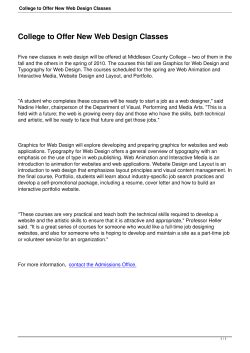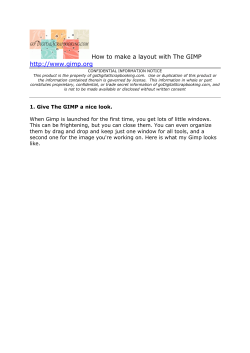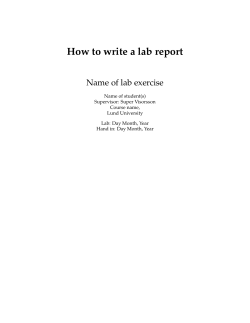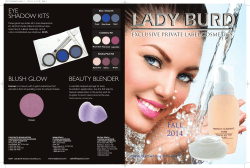
Operations Management – Chapter 9
Operations Management Chapter 9 – Layout Strategies PowerPoint presentation to accompany Heizer/Render Principles of Operations Management, 7e Operations Management, 9e © 2008 Prentice Hall, Inc. 9–1 Outline Global Company Profile: McDonald’s The Strategic Importance of Layout Decisions Types of Layout Office Layout © 2008 Prentice Hall, Inc. 9–2 Outline – Continued Retail Layout Servicescapes Warehousing and Storage Layouts Cross-Docking Random Docking Customizing Fixed-Position Layout © 2008 Prentice Hall, Inc. 9–3 Outline – Continued Process-Oriented Layout Computer Software for ProcessOriented Layouts Work Cells Requirements of Work Cells Staffing and Balancing Work Cells The Focused Work Center and the Focused Factory © 2008 Prentice Hall, Inc. 9–4 Outline – Continued Repetitive and Product-Oriented Layout Assembly-Line Balancing © 2008 Prentice Hall, Inc. 9–5 Learning Objectives When you complete this chapter you should be able to: 1. Discuss important issues in office layout 2. Define the objectives of retail layout 3. Discuss modern warehouse management and terms such as ASRS, cross-docking, and random stocking 4. Identify when fixed-position layouts are appropriate © 2008 Prentice Hall, Inc. 9–6 Learning Objectives When you complete this chapter, you should be able to: 5. Explain how to achieve a good processoriented facility layout 6. Define work cell and the requirements of a work cell 7. Define product-oriented layout 8. Explain how to balance production flow in a repetitive or product-oriented facility © 2008 Prentice Hall, Inc. 9–7 Innovations at McDonald’s Indoor seating (1950s) Drive-through window (1970s) Adding breakfast to the menu (1980s) Adding play areas (late 1980s) Redesign of the kitchens (1990s) Self-service kiosk (2004) Now three separate dining sections © 2008 Prentice Hall, Inc. 9–8 Innovations at McDonald’s Indoor seating (1950s) Drive-through window (1970s) Six out of the Adding breakfast to the menu seven are (1980s) layout Adding play areas (late 1980s) decisions! Redesign of the kitchens (1990s) Self-service kiosk (2004) Now three separate dining sections © 2008 Prentice Hall, Inc. 9–9 McDonald’s New Layout Seventh major innovation Redesigning all 30,000 outlets around the world Three separate dining areas Linger zone with comfortable chairs and Wi-Fi connections Grab and go zone with tall counters Flexible zone for kids and families Facility layout is a source of competitive advantage © 2008 Prentice Hall, Inc. 9 – 10 Strategic Importance of Layout Decisions The objective of layout strategy is to develop a cost-effective layout that will meet a firm’s competitive needs © 2008 Prentice Hall, Inc. 9 – 11 Layout Design Considerations Higher utilization of space, equipment, and people Improved flow of information, materials, or people Improved employee morale and safer working conditions Improved customer/client interaction Flexibility © 2008 Prentice Hall, Inc. 9 – 12 Types of Layout 1. Office layout 2. Retail layout 3. Warehouse layout 4. Fixed-position layout 5. Process-oriented layout 6. Work-cell layout 7. Product-oriented layout © 2008 Prentice Hall, Inc. 9 – 13 Types of Layout 1. Office layout: Positions workers, their equipment, and spaces/offices to provide for movement of information 2. Retail layout: Allocates shelf space and responds to customer behavior 3. Warehouse layout: Addresses tradeoffs between space and material handling © 2008 Prentice Hall, Inc. 9 – 14 Types of Layout 4. Fixed-position layout: Addresses the layout requirements of large, bulky projects such as ships and buildings 5. Process-oriented layout: Deals with low-volume, high-variety production (also called job shop or intermittent production) © 2008 Prentice Hall, Inc. 9 – 15 Types of Layout 6. Work cell layout: Arranges machinery and equipment to focus on production of a single product or group of related products 7. Product-oriented layout: Seeks the best personnel and machine utilizations in repetitive or continuous production © 2008 Prentice Hall, Inc. 9 – 16 Good Layouts Consider 1. Material handling equipment 2. Capacity and space requirements 3. Environment and aesthetics 4. Flows of information 5. Cost of moving between various work areas © 2008 Prentice Hall, Inc. 9 – 17 Layout Strategies Office Retail Warehouse (storage) Examples Allstate Insurance Microsoft Corp. Locate workers requiring frequent contact close to one another Kroger’s Supermarket Federal-Mogul’s warehouse Walgreen’s The Gap’s distribution center Bloomingdale’s Problems/Issues Expose customer to high-margin items Balance low-cost storage with lowcost material handling Table 9.1 © 2008 Prentice Hall, Inc. 9 – 18 Layout Strategies Project (fixed position) Job Shop (process oriented) Examples Ingall Ship Building Corp. Trump Plaza Arnold Palmer Hospital Hard Rock Café Olive Garden Pittsburgh Airport Problems/Issues Move material to the Manage varied material limited storage areas flow for each product around the site Table 9.1 © 2008 Prentice Hall, Inc. 9 – 19 Layout Strategies Work Cells (product families) Repetitive/ Continuous (product oriented) Examples Hallmark Cards Wheeled Coach Standard Aero Problems/Issues Identify a product family, build teams, cross train team members Sony’s TV assembly line Toyota Scion Equalize the task time at each workstation Table 9.1 © 2008 Prentice Hall, Inc. 9 – 20 Office Layout Grouping of workers, their equipment, and spaces to provide comfort, safety, and movement of information Movement of information is main distinction Typically in state of flux due to frequent technological changes © 2008 Prentice Hall, Inc. 9 – 21 Relationship Chart Figure 9.1 © 2008 Prentice Hall, Inc. 9 – 22 Supermarket Retail Layout Objective is to maximize profitability per square foot of floor space Sales and profitability vary directly with customer exposure © 2008 Prentice Hall, Inc. 9 – 23 Five Helpful Ideas for Supermarket Layout 1. Locate high-draw items around the periphery of the store 2. Use prominent locations for high-impulse and high-margin items 3. Distribute power items to both sides of an aisle and disperse them to increase viewing of other items 4. Use end-aisle locations 5. Convey mission of store through careful positioning of lead-off department © 2008 Prentice Hall, Inc. 9 – 24 Store Layout Figure 9.2 © 2008 Prentice Hall, Inc. 9 – 25 Retail Slotting Manufacturers pay fees to retailers to get the retailers to display (slot) their product Contributing factors Limited shelf space An increasing number of new products Better information about sales through POS data collection Closer control of inventory © 2008 Prentice Hall, Inc. 9 – 26 Retail Store Shelf Space Planogram Shampoo Shampoo Shampoo Shampoo Conditioner Shampoo Shampoo Shampoo Conditioner Conditioner Often supplied by manufacturer Shampoo Generated from store’s scanner data on sales Shampoo Computerized tool for shelfspace management 5 facings 2 ft. © 2008 Prentice Hall, Inc. 9 – 27 Servicescapes Ambient conditions - background characteristics such as lighting, sound, smell, and temperature Spatial layout and functionality - which involve customer circulation path planning, aisle characteristics, and product grouping Signs, symbols, and artifacts - characteristics of building design that carry social significance © 2008 Prentice Hall, Inc. 9 – 28 Warehousing and Storage Layouts Objective is to optimize trade-offs between handling costs and costs associated with warehouse space Maximize the total “cube” of the warehouse – utilize its full volume while maintaining low material handling costs © 2008 Prentice Hall, Inc. 9 – 29 Warehousing and Storage Layouts Material Handling Costs All costs associated with the transaction Incoming transport Storage Finding and moving material Outgoing transport Equipment, people, material, supervision, insurance, depreciation Minimize damage and spoilage © 2008 Prentice Hall, Inc. 9 – 30 Warehousing and Storage Layouts Warehouse density tends to vary inversely with the number of different items stored Automated Storage and Retrieval Systems (ASRSs) can significantly improve warehouse productivity by an estimated 500% Dock location is a key design element © 2008 Prentice Hall, Inc. 9 – 31 Cross-Docking Materials are moved directly from receiving to shipping and are not placed in storage in the warehouse Requires tight scheduling and accurate shipments, bar code or RFID identification used for advanced shipment notification as materials are unloaded © 2008 Prentice Hall, Inc. 9 – 32 Random Stocking Typically requires automatic identification systems (AISs) and effective information systems Random assignment of stocking locations allows more efficient use of space Key tasks 1. Maintain list of open locations 2. Maintain accurate records 3. Sequence items to minimize travel, pick time 4. Combine picking orders 5. Assign classes of items to particular areas © 2008 Prentice Hall, Inc. 9 – 33 Customizing Value-added activities performed at the warehouse Enable low cost and rapid response strategies Assembly of components Loading software Repairs Customized labeling and packaging © 2008 Prentice Hall, Inc. 9 – 34 Warehouse Layout Traditional Layout Customization Storage racks Conveyor Staging Office Shipping and receiving docks © 2008 Prentice Hall, Inc. 9 – 35 Warehouse Layout Cross-Docking Layout Office Shipping and receiving docks Shipping and receiving docks © 2008 Prentice Hall, Inc. 9 – 36 Fixed-Position Layout Product remains in one place Workers and equipment come to site Complicating factors Limited space at site Different materials required at different stages of the project Volume of materials needed is dynamic © 2008 Prentice Hall, Inc. 9 – 37 Alternative Strategy As much of the project as possible is completed off-site in a productoriented facility This can significantly improve efficiency but is only possible when multiple similar units need to be created © 2008 Prentice Hall, Inc. 9 – 38 Process-Oriented Layout Like machines and equipment are grouped together Flexible and capable of handling a wide variety of products or services Scheduling can be difficult and setup, material handling, and labor costs can be high © 2008 Prentice Hall, Inc. 9 – 39 Process-Oriented Layout Patient A - broken leg ER triage room Emergency room admissions Patient B - erratic heart pacemaker Surgery Laboratories Radiology ER Beds Pharmacy Billing/exit Figure 9.3 © 2008 Prentice Hall, Inc. 9 – 40 Layout at Arnold Palmer Hospital Pie-shaped rooms Central break and medical supply rooms Local linen supply © 2008 Prentice Hall, Inc. Central nurses station Local nursing pod 9 – 41 Process-Oriented Layout Arrange work centers so as to minimize the costs of material handling Basic cost elements are Number of loads (or people) moving between centers Distance loads (or people) move between centers © 2008 Prentice Hall, Inc. 9 – 42 Process-Oriented Layout n Minimize cost = ∑ n ∑ Xij Cij i=1 j=1 where © 2008 Prentice Hall, Inc. n = total number of work centers or departments i, j = individual departments Xij = number of loads moved from department i to department j Cij = cost to move a load between department i and department j 9 – 43 Process Layout Example Arrange six departments in a factory to minimize the material handling costs. Each department is 20 x 20 feet and the building is 60 feet long and 40 feet wide. 1. Construct a “from-to matrix” 2. Determine the space requirements 3. Develop an initial schematic diagram 4. Determine the cost of this layout 5. Try to improve the layout 6. Prepare a detailed plan © 2008 Prentice Hall, Inc. 9 – 44 Process Layout Example Number of loads per week Department Assembly Painting (1) (2) Assembly (1) Painting (2) Machine Shop (3) Receiving (4) Shipping (5) 50 Machine Receiving Shop (3) (4) Shipping (5) Testing (6) 100 0 0 20 30 50 10 0 20 0 100 50 0 0 Testing (6) Figure 9.4 © 2008 Prentice Hall, Inc. 9 – 45 Process Layout Example Area 1 Area 2 Area 3 Assembly Department (1) Painting Department (2) Machine Shop Department (3) 40’ Figure 9.5 © 2008 Prentice Hall, Inc. Receiving Department (4) Shipping Department (5) Testing Department (6) Area 4 Area 5 Area 6 60’ 9 – 46 Process Layout Example Interdepartmental Flow Graph 100 1 50 2 30 3 10 100 4 50 5 6 Figure 9.6 © 2008 Prentice Hall, Inc. 9 – 47 Process Layout Example n Cost = ∑ n ∑ Xij Cij i=1 j=1 Cost = $50 + $200 + $40 (1 and 2) (1 and 3) (1 and 6) + $30 + $50 + $10 (2 and 3) (2 and 4) (2 and 5) + $40 + $100 + $50 (3 and 4) (3 and 6) (4 and 5) = $570 © 2008 Prentice Hall, Inc. 9 – 48 Process Layout Example Revised Interdepartmental Flow Graph 30 50 2 1 100 3 50 4 100 50 5 6 Figure 9.7 © 2008 Prentice Hall, Inc. 9 – 49 Process Layout Example n Cost = ∑ n ∑ Xij Cij i=1 j=1 Cost = $50 + $100 + $20 (1 and 2) (1 and 3) (1 and 6) + $60 + $50 + $10 (2 and 3) (2 and 4) (2 and 5) + $40 + $100 + $50 (3 and 4) (3 and 6) (4 and 5) = $480 © 2008 Prentice Hall, Inc. 9 – 50 Process Layout Example Area 1 Area 2 Area 3 Painting Department (2) Assembly Department (1) Machine Shop Department (3) 40’ Figure 9.8 © 2008 Prentice Hall, Inc. Receiving Department (4) Shipping Department (5) Testing Department (6) Area 4 Area 5 Area 6 60’ 9 – 51 Computer Software Graphical approach only works for small problems Computer programs are available to solve bigger problems CRAFT ALDEP CORELAP Factory Flow © 2008 Prentice Hall, Inc. 9 – 52 CRAFT Example PATTERN 3 4 5 1 2 1 D D D D B B B 2 D D D D B B D D 3 D D D E E E D D D 4 C C D E E F F F F D 5 A A A A A F E E E D 6 A A A F F F 1 2 1 A A A A B B 2 A A A A B 3 D D D D 4 C C D 5 F F 6 E E TOTAL COST 20,100 EST. COST REDUCTION ITERATION 0 (a) © 2008 Prentice Hall, Inc. PATTERN 3 4 5 6 .00 TOTAL COST 14,390 EST. COST REDUCTION ITERATION 3 (b) 6 70. Figure 9.9 9 – 53 Computer Software Three dimensional visualization software allows managers to view possible layouts and assess process, material handling, efficiency, and safety issues © 2008 Prentice Hall, Inc. 9 – 54 Work Cells Reorganizes people and machines into groups to focus on single products or product groups Group technology identifies products that have similar characteristics for particular cells Volume must justify cells Cells can be reconfigured as designs or volume changes © 2008 Prentice Hall, Inc. 9 – 55 Advantages of Work Cells 1. Reduced work-in-process inventory 2. Less floor space required 3. Reduced raw material and finished goods inventory 4. Reduced direct labor 5. Heightened sense of employee participation 6. Increased use of equipment and machinery 7. Reduced investment in machinery and equipment © 2008 Prentice Hall, Inc. 9 – 56 Improving Layouts Using Work Cells Current layout - workers in small closed areas. Cannot increase output without a third worker and third set of equipment. Improved layout - cross-trained workers can assist each other. May be able to add a third worker as additional output is needed. Figure 9.10 (a) © 2008 Prentice Hall, Inc. 9 – 57 Improving Layouts Using Work Cells Current layout - straight lines make it hard to balance tasks because work may not be divided evenly Figure 9.10 (b) © 2008 Prentice Hall, Inc. Improved layout - in U shape, workers have better access. Four cross-trained workers were reduced. U-shaped line may reduce employee movement and space requirements while enhancing communication, reducing the number of workers, and facilitating inspection 9 – 58 Requirements of Work Cells 1. Identification of families of products 2. A high level of training, flexibility and empowerment of employees 3. Being self-contained, with its own equipment and resources 4. Test (poka-yoke) at each station in the cell © 2008 Prentice Hall, Inc. 9 – 59 Staffing and Balancing Work Cells Determine the takt time Total work time available Takt time = Units required Determine the number of operators required Total operation time required Workers required = Takt time © 2008 Prentice Hall, Inc. 9 – 60 Staffing Work Cells Example Standard time required 600 Mirrors per day required Mirror production scheduled for 8 hours per day From a work balance chart 60 total operation time 50 = 140 seconds 40 30 20 10 0 Assemble Paint Test Label Pack for shipment Operations © 2008 Prentice Hall, Inc. 9 – 61 Staffing Work Cells Example 600 Mirrors per day required Mirror production scheduled for 8 hours per day From a work balance chart total operation time = 140 seconds Takt time = (8 hrs x 60 mins) / 600 units = .8 mins = 48 seconds Total operation time required Workers required = Takt time = 140 / 48 = 2.91 © 2008 Prentice Hall, Inc. 9 – 62 Work Balance Charts Used for evaluating operation times in work cells Can help identify bottleneck operations Flexible, cross-trained employees can help address labor bottlenecks Machine bottlenecks may require other approaches © 2008 Prentice Hall, Inc. 9 – 63 Focused Work Center and Focused Factory Focused Work Center Identify a large family of similar products that have a large and stable demand Moves production from a general-purpose, process-oriented facility to a large work cell Focused Factory A focused work cell in a separate facility May be focused by product line, layout, quality, new product introduction, flexibility, or other requirements © 2008 Prentice Hall, Inc. 9 – 64 Focused Work Center and Focused Factory Work Cell Focused Work Center A work cell is a temporary productoriented arrangement of machines and personnel in what is ordinarily a processoriented facility. A focused work center is a permanent productoriented arrangement of machines and personnel in what is ordinarily a processoriented facility. Example: A job shop Example: Pipe bracket with machinery and manufacturing at a personnel rearranged shipyard. to produce 300 unique control panels. © 2008 Prentice Hall, Inc. Focused Factory A focused factory is a permanent facility to produce a product or component in a product-oriented facility. Many focused factories currently being built were originally part of a process-oriented facility. Example: A plant to produce window mechanism for automobiles. Table 9.2 9 – 65 Repetitive and ProductOriented Layout Organized around products or families of similar high-volume, low-variety products 1. Volume is adequate for high equipment utilization 2. Product demand is stable enough to justify high investment in specialized equipment 3. Product is standardized or approaching a phase of life cycle that justifies investment 4. Supplies of raw materials and components are adequate and of uniform quality © 2008 Prentice Hall, Inc. 9 – 66 Product-Oriented Layouts Fabrication line Builds components on a series of machines Machine-paced Require mechanical or engineering changes to balance Assembly line Puts fabricated parts together at a series of workstations Paced by work tasks Balanced by moving tasks Both types of lines must be balanced so that the time to perform the work at each station is the same © 2008 Prentice Hall, Inc. 9 – 67 Product-Oriented Layouts Advantages 1. 2. 3. 4. 5. Low variable cost per unit Low material handling costs Reduced work-in-process inventories Easier training and supervision Rapid throughput Disadvantages 1. High volume is required 2. Work stoppage at any point ties up the whole operation 3. Lack of flexibility in product or production rates © 2008 Prentice Hall, Inc. 9 – 68 McDonald’s Assembly Line Figure 9.12 © 2008 Prentice Hall, Inc. 9 – 69 Disassembly Lines • Disassembly is being considered in new product designs • “Green” issues and recycling standards are important consideration • Automotive disassembly is the 16th largest industry in the US © 2008 Prentice Hall, Inc. 9 – 70 Assembly-Line Balancing Objective is to minimize the imbalance between machines or personnel while meeting required output Starts with the precedence relationships 1. Determine cycle time 2. Calculate theoretical minimum number of workstations 3. Balance the line by assigning specific tasks to workstations © 2008 Prentice Hall, Inc. 9 – 71 Wing Component Example Performance Time Task (minutes) A 10 B 11 C 5 D 4 E 12 F 3 G 7 H 11 I 3 Total time 66 © 2008 Prentice Hall, Inc. Task Must Follow Task Listed Below — A B B A C, D F E G, H This means that tasks B and E cannot be done until task A has been completed 9 – 72 Wing Component Example Performance Time Task (minutes) A 10 B 11 C 5 D 4 E 12 F 3 G 7 H 11 I 3 Total time 66 Task Must Follow Task Listed Below — A B B A C, D F E G, H 5 10 11 A B C 3 7 F G 4 12 E D 3 11 I H Figure 9.13 © 2008 Prentice Hall, Inc. 9 – 73 Wing Component Example Performance Time Task (minutes) A 10 B 11 C 5 D 4 E 12 F 3 G 7 H 11 I 3 Total time 66 480 available mins per day 40 units required Task Must Follow Task Listed Below — A Production time B available per day Cycle B time = Units required per day A = 480 / 40 5 C, D = 12 minutes per unit C F 10 11 3 7 n E for taskFi A ∑ Time B G Minimum G, H i=1 4 number of = workstations Cycle Dtime 12 11 3 I = 66 / 12 E H = 5.5 or 6 stations Figure 9.13 © 2008 Prentice Hall, Inc. 9 – 74 WingLine-Balancing Component Example Heuristics 1. Longest task time Choose the available 480 task available Performance Task Must Follow with the longest task time mins per day Time Task Listed Task2. Most (minutes) 40 task units required following tasksBelow Choose the available number of= 12 mins A 10 —with the largestCycle time B 11 Afollowing tasksMinimum = 5.5 or 6 C 3. Ranked5 positional BChoose the available workstations task for D Bwhich the sum of following weight4 E 12 Atask times is the longest 5 F 3 C, D the available C task G 4. Shortest 7 task time FChoose 10 shortest 11 3 7 with the task time H 11 E A B G F I 5. Least number 3 G, H of Choose the available task 4 3 with the least number of Totalfollowing time 66 tasks D I 12 11 following tasks E H Table 9.4 Figure 9.13 © 2008 Prentice Hall, Inc. 9 – 75 Wing Component Example Performance Time Task (minutes) A 10 B 11 Station C 52 D 4 11 E 10 12 F A B 3 G 7 H 11 I 3 12 Stationtime 66 Total E 1 Station 4 © 2008 Prentice Hall, Inc. 480 available mins per day 40 units required Task Must Follow Task Listed Below — A 5 B C B A C, D 4 F D E G, H Cycle time = 12 mins Minimum workstations = 5.5 or 6 3 7 F G Station 3 3 I 11 Station 6 H Station 5 Figure 9.14 9 – 76 Wing Component Example Performance Time Task (minutes) Task Must Follow Task Listed Below 480 available mins per day 40 units required A 10 — Cycle time = 12 mins B 11 A Minimum C 5 B workstations = 5.5 or 6 D 4 B E 12 A F 3 C, D ∑ Task times G 7 F Efficiency = (Actual number ofEworkstations) x (Largest cycle time) H 11 I 3 G, H = 66 minutes / (6 stations) x (12 minutes) Total time 66 = 91.7% © 2008 Prentice Hall, Inc. 9 – 77
© Copyright 2025









